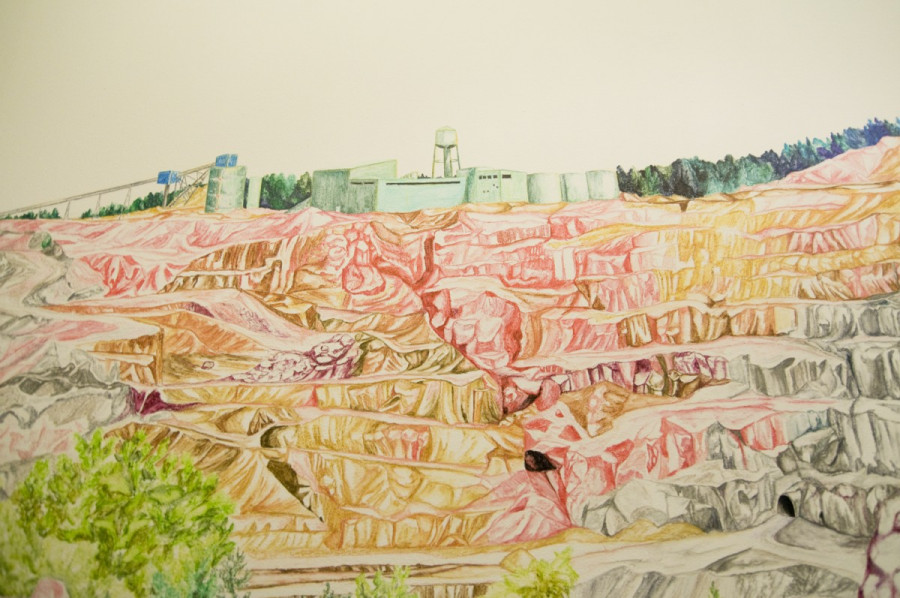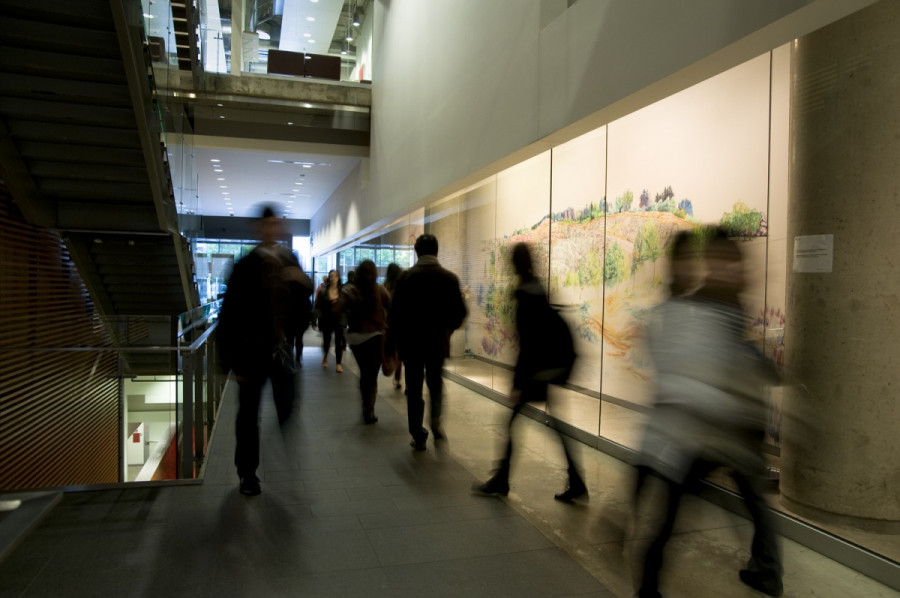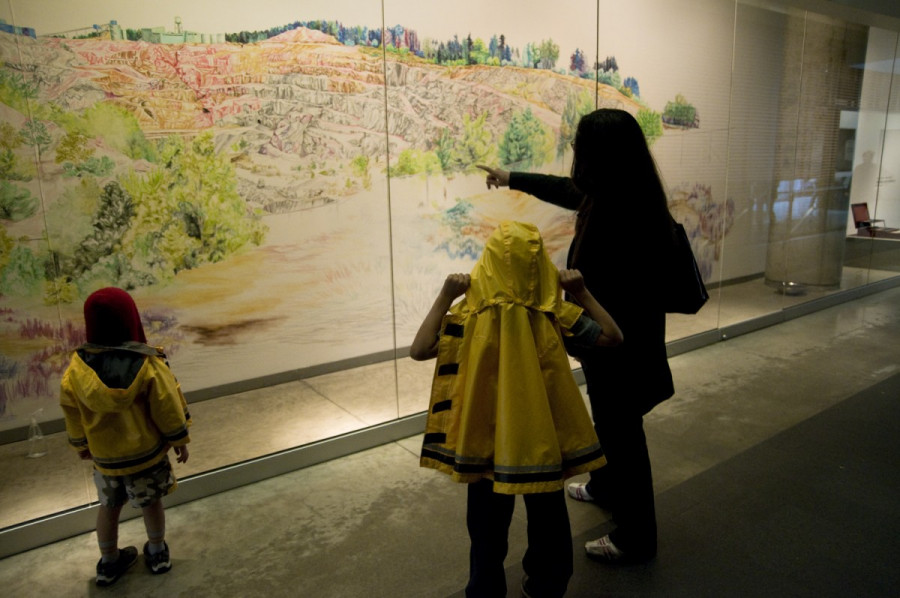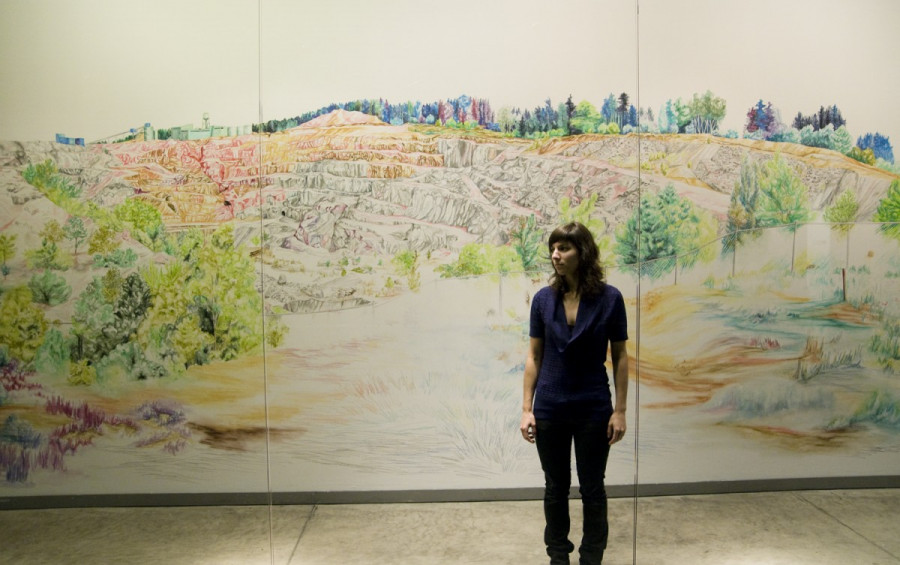Walking With a Ghost
EV Installation Reflects on Dead Strangers, Landscapes
It begins with a box.
Six years ago, Andréanne Godin received an unused, limited-edition box of Derwent watercolour pencils. The elegant wooden chest, one of only 1,000 ever produced, had previously belonged to a complete stranger, a woman now deceased. For six years the box sat in Godin’s home, silently challenging her to create something worthy of a stranger’s memory.
This year, she did.
“It’s a statement on ephemerality,” says Godin, now an MFA student at Concordia. “From the first mark, its destiny is to [be] lost.”
Memorial For a Stranger, an ongoing exhibit in the York Corridor vitrines of the EV building’s first floor, is a work constantly in flux, uniting this mysterious gift with the landscape of Godin’s childhood. The mural depicts a panoramic vista, drawn from memory, of an open-pit mine that devastated the natural landscape of the Quebec mining region of Val d’Or, where Godin grew up.
Despite the harshness of the mine’s presence in the wilderness, the mural’s use of vibrant colour makes the vista breathtakingly beautiful.
The work is a memorial both for a person, a stranger, and a landscape, thoroughly familiar, both of which exist now only in memory. It’s this statement of ephemerality that unites the two foci of Godin’s work.
“To see everything change just to exploit that land,” Godin muses, “[are] very drastic changes in nature, in landscapes that I was so close to, it was almost like losing a member of the family. Every day you’re reminded that you’ve allowed this to happen to your land.”
A departure from her usual black-and-white compositions, Memorial for a Stranger nonetheless follows Godin’s interest in projects of a dualistic nature. Past works have focused on the interactions between sound installation and static composition.
“For me it’s really interesting to work [with the] three-dimensionality of sound and two-dimensional drawing, and how these two things can [be in] dialogue even if the sound is progressing and changing and the drawing is just there.”
The project is a work in transition, and its execution will not be truly complete until it’s dismantled. Godin has been working on the nostalgic landscape since September, using the colours of the Derwent pencil set as her guide.
“This week I will erase all of the trees, everything that is organic, that can change on its own,” Godin explained. “The mine will stay for a week and then [it] will go down. It’s a reflection about [how] when we mine landscapes, when we change things as humans, these changes [last] much longer than our lifetime.”
The landscape, drawn directly on the walls of the York corridor, merges realism with the abstract, the mineral composition of the climbing rock face in contrast with the surreal wash of mauves and indigos of the forest and the deep evergreens of organic life. The overall effect is dreamlike; even the mine is illustrated with sympathetic and vibrant attention to detail.
The project is now in its second phase, as Godin uses a spray bottle and various recycled fabrics to gently efface portions of the landscape, blurring details and delineations. There is a method behind this process of dismantling, a further reflection on the decomposition of the region.
“This week I will erase all of the trees, everything that is organic, that can change on its own,” Godin explained. “The mine will stay for a week and then [it] will go down. It’s a reflection about [how] when we mine landscapes, when we change things as humans, these changes [last] much longer than our lifetime.”
The exhibit has exacted a physical and emotional toll on the artist. In addition to the back and wrist aches developed from hours of working against the wall, there is a profound sense of loss in the gradual erasure of these months of effort.
“Everything that the box represents for me is so important that I don’t want to lose any bit of it.”
There has been a similarly visceral reaction from fans and critics of the work, particularly those who would like it to be preserved in permanent form. When the exhibit is finished, the wall will be washed clean and the Derwent box will be virtually empty—this painful process of erasure mirroring the very cyclical nature of human existence.
“It’s interesting to think about all of the cycles [of nature]. They are cycles as we are cycles, as we are ephemeral.”
On Oct. 26, Godin will be giving a talk to further illuminate the process and motivations of this ambitious undertaking, and the pressure of doing justice to a stranger’s memory.
Appropriately, in a few short weeks the piece, too, will exist only through recollection. Pass by the York corridor vitrines before Nov. 4 to participate in this colourful meditation on impermanence and celebration of life even in its most fleeting forms.






